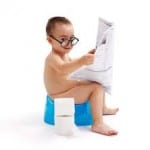13 Toilet Training Tips to Know Before You Start
1. Parent and child must work together
Toilet training is a partnership, with proper roles assigned to each person. You can lead a baby to the bathroom, but you can't make him go.
2. Don't be in a hurry
You have not failed Parenting 101 if your baby is the last on the block to be dry. As with eating and sleeping, you can't and shouldn't force a baby to be dry or clean, but you can set the conditions that help baby toilet train himself.
3. Help your baby achieve a healthy toilet training attitude
Approach toilet training as an exciting interaction rather than a dreaded task; consider this event an initiation into your role as instructor. From baby's viewpoint, toileting is his initiation into "bigness"-a rite of passage from toddlerhood into preschoolerhood. (This explains why the desire to stay little makes some procrastinators resist.)
4. Toilet training is a complex skill
Before you rush baby to the potty at the first squat, consider what's involved in learning toileting skills. First, baby has to be aware of the pressure sensations of his bowel and bladder. Then he must make the connection between these sensations and what's happening inside his body. Next he learns to respond to these urges by running to the potty, where he must know how to remove his clothes, how to situate himself comfortably on this new kind of seat and how to hold his urges until all systems are go. With all these steps, it's no wonder many babies are still in diapers well into the third year.
5. The muscles surrounding the opening of the bladder and bowel
I call them doughnut muscles when explaining the elimination process to six-year-old bed wetters, and they need to be controlled to open and close at the proper time. Bowel training usually precedes bladder training, mainly because the doughnut muscles surrounding the bowel are not as impatient as those around the bladder. When a baby senses the urge to defecate, he has more time to respond before soiling his diapers. A solid substance is easier to control than liquid. When the bladder is full, the urge to go is sudden, strong, and hard to control.
6. The usual sequence of gaining bowel and bladder control
(1) nighttime bowel control; (2) daytime bowel control; (3) daytime bladder control; (4) nighttime bladder control.
7. Girls are rumored to be trained earlier than boys
This observation reflects more the sex of the trainer than the trainee. Culturally, toilet training has been left to mothers. Naturally, women feel more comfortable training girls, and baby girls are more likely to imitate their mommies. Picture mommy standing and trying to show baby Bert how to urinate. By imitation, babies learn that girls sit and boys stand, but in the beginning boys can sit, avoiding sprays and dribbles on walls and floor. When your son figures out he can stand just like daddy, he will.
8. The pressure is off parents to toilet train early
Don't equate toilet training with good mothering. The idea that the earlier baby is eating three squares a day, weaned, toilet trained, and independent, the "better" the mother is nonsense.
9. We do not mean to imply that you leave baby alone until he is old enough to order his own potty-chair
Some toilet training is necessary on the parents' part, and some learning is needed by the baby. Children need parental guidance to get control of their bodies.
10. The temperament of the mother and baby play a role in readiness
A down-to-business baby tends to learn quickly and may even "train himself," especially if he has a mother who thinks the same way, but who is wise enough not to pressure. A laid-back baby with a casual mother may still be in diapers at three years and no one worries. With a laid-back baby and a down-to-business mother toilet training gets more challenging.
11. Take the pressure off you and baby
Don't cave in to in-law pressure. You know when your infant is ready. Of course, the "diaper-free" policy at your desired preschool looms over you like a due date.
12. Research shows that toddlers are being toilet trained later than in the past
To go along with this trend diaper companies are making bigger and better diapers. Children learn to use the toilet the same way they learn to walk and talk: by imitating their caregivers and when the appropriate nerves and muscles are mature enough to be coordinated. For these reasons, the time of training will vary from home to home and child to child.
13. Toilet training is so difficult for parents and a battle for toddlers because
- The infant was encouraged to use the diaper as a toilet, so the toddler has to unlearn what he has previously been taught.

- The child has not yet developed body language to make the connection between feeling and going, since prior to toilet-training, parents were not looking for these cues and the baby did not give them.
- Toddlers, especially boys, are on the go and the last thing they want to do is "sit still" on the potty.

